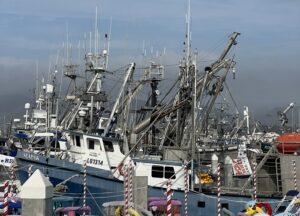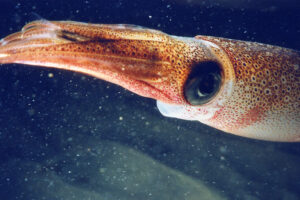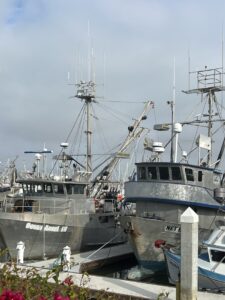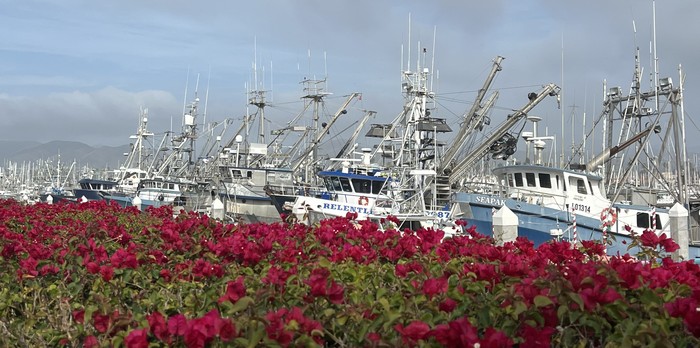Why are squid such an important pursuit?
by Nella Nelson
 The chugging and clanging of massive metallic vessels loaded with heavy equipment and lights are making a presence in our harbor. You may recognize that they are squid boats, making their annual voyage, some from as far as Alaska, and returning with bounteous catches of market squid. Let’s take a closer look into the life of a squid boat and the creature they are catching.
The chugging and clanging of massive metallic vessels loaded with heavy equipment and lights are making a presence in our harbor. You may recognize that they are squid boats, making their annual voyage, some from as far as Alaska, and returning with bounteous catches of market squid. Let’s take a closer look into the life of a squid boat and the creature they are catching.
Two types of boats are used in this harvest, which takes place from October through April or May in Southern California. One is a squid seiner. The seiner is a vessel that works alongside light boats (smaller boats with high powered lights pointed from various angles). Purse seins are long vertical nets that draw and purse the bottom closed to capture fish. The lights used by the second boat are aimed to attract groups of spawning squid to the surface. When the squid emerge to the surface, the light boat signals the seiner to deploy the net, encircling the light boat, in order to make the catch. Hence, the bright lights of this season can be seen from our shores at night or in the darkness of early mornings.
 Why are squid such an important pursuit? California market squid are a major source of bait for the recreational fishing industry, although more than 80% is exported to China. According to a UCSD study, 82% of the 2001 catch was exported for secondary processing and human consumption while the remainder was domestically for consumption, pet food and bait. In 2022, 18,082 tons of squid was caught in Ventura alone, equaling 28% of California’s total catch.
Why are squid such an important pursuit? California market squid are a major source of bait for the recreational fishing industry, although more than 80% is exported to China. According to a UCSD study, 82% of the 2001 catch was exported for secondary processing and human consumption while the remainder was domestically for consumption, pet food and bait. In 2022, 18,082 tons of squid was caught in Ventura alone, equaling 28% of California’s total catch.
Ventura Harbor continues to be the premier landing port for California Market Squid. Our Ventura Harbor Village Marina can accommodate 54 squid seine vessels at any given time and is currently permanent home to 44 squid seiners. No other single marina on the west coast south of Alaska can accommodate as many seiners at one time as our harbor.
There’s more to it. According to manager of commercial fisheries and technology at Ventura Harbor Village Marina, Frank Locklear, “Fishing is the lifeblood of this harbor and squid is the key.” Locklear also stressed that squid fishing is crucial to both local fishing companies and the harbor as a whole. The harbor uses part of the revenue it receives to send representation to Washington DC to get funding it needs for dredging, which removes sand and sediment from the harbor’s entrance. This is necessary for the vessels occupying the marinas to get in and out of the harbor. Without regular dredging, boats cannot enter or exit.”
 Ensuring that fishermen capture squid that have already spawned is key to the production of the next generation and the future health of the population. Since squid have a short lifespan (6-9 months), fishermen target spawning squid because they die shortly after they reproduce. Even without fishing, the entire population replaces itself annually.
Ensuring that fishermen capture squid that have already spawned is key to the production of the next generation and the future health of the population. Since squid have a short lifespan (6-9 months), fishermen target spawning squid because they die shortly after they reproduce. Even without fishing, the entire population replaces itself annually.
Market squid live in depths of up to 2,600 ft. and to the surface. They prefer salty ocean and are rarely found in estuaries or river mouths. They are of the mollusk family known as cephalopods, which means “foot-on-head”. They have eight arms and two tentacles which extend from the ends of their bodies where their mouths are located. Females produce about 20 egg cases, each containing 200 individual eggs. Market squid, therefore, are an abundant source of food for humans as well as rockfish, sea birds and marine mammals of our local coast.
Sources:
NOAA fisheries – fisheries.noaa.gov
Ventura Port District – venturaharbor.com
Hersko, Tyler. Ventura County Star. Several Hundred Tons of Squid Offloaded in Ventura Nov 7, 2017 https://caseagrant.ucsd.edu/sites/default/files/27833.pdf Ask Laura

